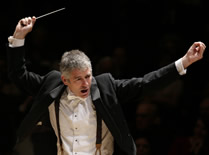There are great contrasts in Brahms’ Ein deutches Requiem, Op. 45: pianissimo passages open and close the work, but heaven-storming fortissimos appear in movements II, III, and VI; Brahmsian lyrical melodies abound, but are sometimes transformed into marcato fugal lines; the orchestral writing is almost organistic as Brahms scores various passages for woodwinds only, or for lower strings only (the first violins do not play until movement II). All these contrasts were in evidence in Grant Llewellyn’s concept for the North Carolina Symphony of this enduring work, often described as “a requiem for the living rather than for the dead.”
In his opening remarks, Llewellyn noted the recent death of Pulitzer Prize-winning composer, educator, and North Carolinian Robert Ward at age 95. The musicians dedicated their performances of the Requiem to Ward’s memory even as they remembered his attendance at a February, 2013 NC Symphony concert at which his “Jubilation Overture” was performed.
Overall, the performance was excellent and well-received by the large audience. With the exception of the second-movement fugue’s overly-brisk alla breve tempo, where Llewellyn ignored the “non troppo” part of Brahms’ tempo indication, allegro non troppo, the conductor’s pacing was superb. The ninety-nine members of the NC Master Chorale produced some exquisite quiet passages and acquitted themselves well in the forte sections as well. Curiously, the soprano section, often the surest portion of a symphonic chorus, took a back seat to the altos, tenors, and basses in this performance in their singing of the long, lyrical lines which occur so frequently in this work. The choral blend of the three lower sections was exemplary; less so with the soprano section, which had an ‘edge’ to its sound, especially in the early going. The Chorale’s German diction was excellent save for their umlaut problem in “müssen,” which came out rather clearly as “moosen.”
The third-movement fugue (“Der Gerechten Seelen sind in Gottes Hand und keine Qual rühret sie an” / “The souls of the righteous are in God’s hand, and no pain shall disturb them.”) is often problematic because the music can seem to contradict the text’s mood of assured faith. Conductors are often misled by two of Brahms’ markings in the score: “ben marcato” and “sempre con tutta la forza.” The problem is that neither of these directions applies to the chorus, or, indeed, to the entire orchestra, but only to the timpani and selected contrabasses. The lyricism of the soprano and tenor melismas on the word “Qual” was lost when the marcato treatment required that the singers insert rests in place of tied eighth-notes. An unfortunate intermission was inserted after the third movement, thus breaking the continuity of the work.
Baritone Mark Schnaible sang both his bravura and lyrical passages with assuredness and fine tone. If he is able to watch a video of his performance, he will likely realize that the dramatic motions of his right hand distract from his overall excellent performance.
While soprano Ilana Davidson has a lovely sound, especially in her upper registers, her voice was not well-suited to the demands placed on the soprano soloist by Brahms. She had to insert breaths in the midst of her opening phrase (“Ihr habt nun // Traurigkeit”) and its later recurrence, and her voice lacked the weight to carry well over the orchestra and chorus.
When Brahms was asked why he chose to select Biblical verses rather than using the traditional text of the requiem mass, he said, “I am writing for humanity as a whole.” One cannot listen to this music without becoming more aware of the hope for what lies ahead which is part of being human. Thanks to Grant Llewellyn, the NC Symphony, and the NC Master Chorale for letting us experience that message in their moving performance of Brahms’ masterwork.
This program will be repeated at 8:00 PM on April 13 in Raleigh and on April 14 in Chapel Hill, NC. See the sidebar for details.











